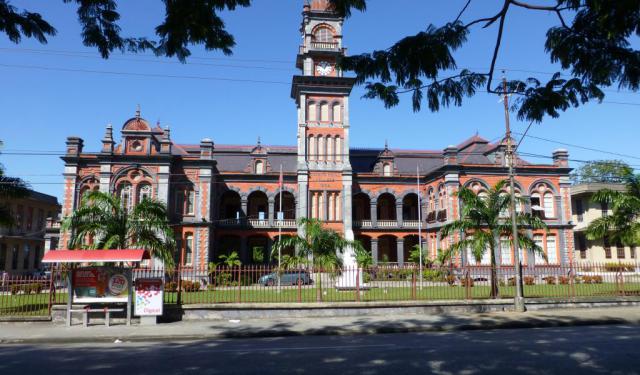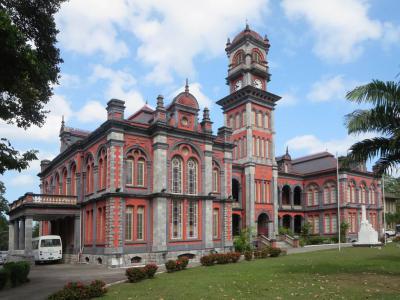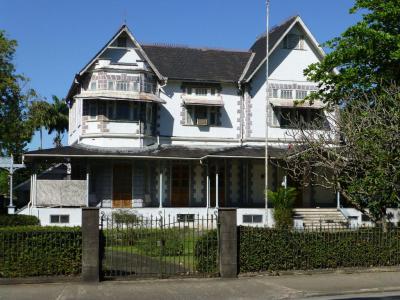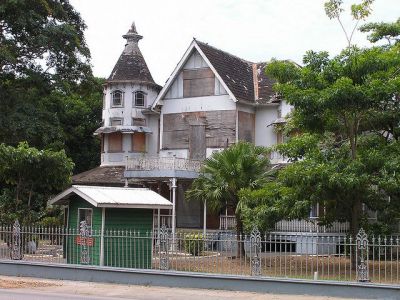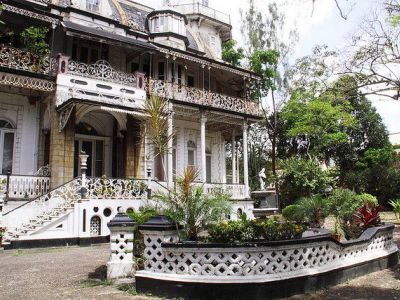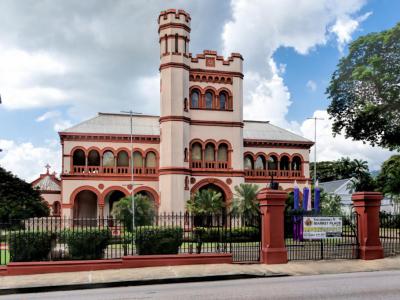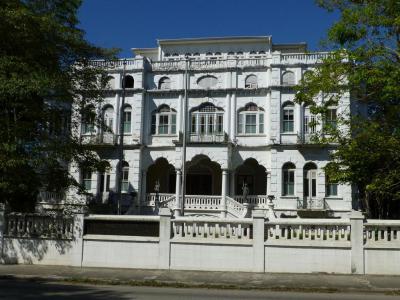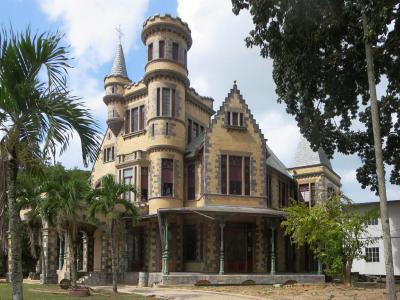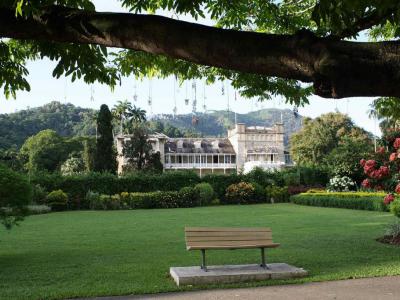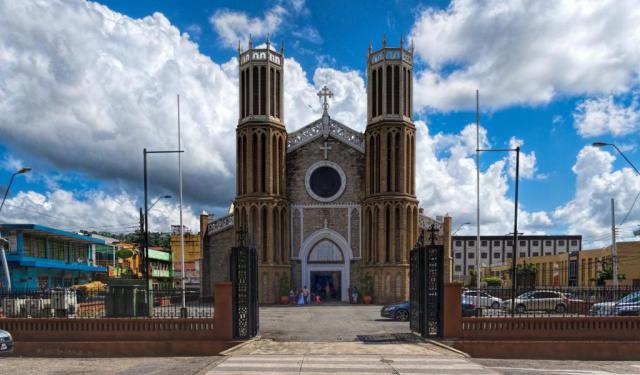Historic Buildings Walking Tour (Self Guided), Port of Spain
A group of mansions in northern Port of Spain, located on Maraval Road, to the west of the Queen's Park Savannah, is known colloquially as “The Magnificent Seven”. They were built between 1902 and 1910 on the land that was previously used as a government stock farm. Together with the nearby President's House, the official residence of the President of Trinidad and Tobago, which is just “round the corner”, next to the Royal Botanic Gardens, these buildings are listed as heritage sites by the country's National Trust.
These structures feature an array of architectural styles, such as French Colonial, Scottish Baronial, Indian Empire, and Moorish Mediterranean-often blended with Caribbean architecture. Many of them have unusual elements, like the chiming clock and lighted clock tower of Queen's Royal College, and the Scottish cast iron elements coupled with traditional Demerara windows in Hayes Court.
Some of the houses are made of imported materials, like Italian marble and white limestone of Barbados, and most of them have retained the aesthetics of their original designs. Stollmeyer's Castle, the first building in the neighborhood, is said to be modeled after a wing of Balmoral Castle, a residence of the British royal family in Aberdeenshire, Scotland.
The majority of these properties were originally built as residences and kept within families for decades. Archbishop's House was built as, and still remains, the official home of the Archbishop of Port of Spain, while the Anglican Bishop to Trinidad lives in Hayes Court. Queen's Royal College was built as a secondary school for boys.
White Hall, in its turn, was used as the Office of the Prime Minister, from 1963 to 2009, and together with Stollmeyer's Castle, it falls under the purview of the PM's Office. Both buildings underwent profound restoration so they could be used by foreign dignitaries visiting the country.
As for the President's House, today, apart from being the President's private residence, it is used for national awards and swearing-in ceremonies, as well as for diplomatic receptions.
For a more detailed acquaintance with these marvelous structures, take our self-guided walking tour.
These structures feature an array of architectural styles, such as French Colonial, Scottish Baronial, Indian Empire, and Moorish Mediterranean-often blended with Caribbean architecture. Many of them have unusual elements, like the chiming clock and lighted clock tower of Queen's Royal College, and the Scottish cast iron elements coupled with traditional Demerara windows in Hayes Court.
Some of the houses are made of imported materials, like Italian marble and white limestone of Barbados, and most of them have retained the aesthetics of their original designs. Stollmeyer's Castle, the first building in the neighborhood, is said to be modeled after a wing of Balmoral Castle, a residence of the British royal family in Aberdeenshire, Scotland.
The majority of these properties were originally built as residences and kept within families for decades. Archbishop's House was built as, and still remains, the official home of the Archbishop of Port of Spain, while the Anglican Bishop to Trinidad lives in Hayes Court. Queen's Royal College was built as a secondary school for boys.
White Hall, in its turn, was used as the Office of the Prime Minister, from 1963 to 2009, and together with Stollmeyer's Castle, it falls under the purview of the PM's Office. Both buildings underwent profound restoration so they could be used by foreign dignitaries visiting the country.
As for the President's House, today, apart from being the President's private residence, it is used for national awards and swearing-in ceremonies, as well as for diplomatic receptions.
For a more detailed acquaintance with these marvelous structures, take our self-guided walking tour.
How it works: Download the app "GPSmyCity: Walks in 1K+ Cities" from Apple App Store or Google Play Store to your mobile phone or tablet. The app turns your mobile device into a personal tour guide and its built-in GPS navigation functions guide you from one tour stop to next. The app works offline, so no data plan is needed when traveling abroad.
Historic Buildings Walking Tour Map
Guide Name: Historic Buildings Walking Tour
Guide Location: Trinidad and Tobago » Port of Spain (See other walking tours in Port of Spain)
Guide Type: Self-guided Walking Tour (Sightseeing)
# of Attractions: 8
Tour Duration: 1 Hour(s)
Travel Distance: 1.1 Km or 0.7 Miles
Author: sabrina
Sight(s) Featured in This Guide:
Guide Location: Trinidad and Tobago » Port of Spain (See other walking tours in Port of Spain)
Guide Type: Self-guided Walking Tour (Sightseeing)
# of Attractions: 8
Tour Duration: 1 Hour(s)
Travel Distance: 1.1 Km or 0.7 Miles
Author: sabrina
Sight(s) Featured in This Guide:
- Queen's Royal College
- Hayes Court
- Mille Fleurs
- Ambard's House (Roomor)
- Archbishop's House
- White Hall
- Stollmeyer's Castle
- President's House
1) Queen's Royal College
Queen's Royal College (QRC), often called "The College" by its alumni, is one of Trinidad and Tobago's most prestigious secondary schools. Located in Saint Clair, Port of Spain, this institution is celebrated for its German Renaissance architecture, rigorous academics, and a legacy of notable alumni in sports, politics, and science both locally and internationally.
QRC originated from the Stuart Grammar School in Port of Spain. In 1859, its principal, Edward Stuart, helped establish the Queen's Collegiate School, which opened near Lord Harris Square. Renamed Queen's Royal College in 1870, it moved to the Prince's Building and maintained a secular ethos to offer superior education to all races and religions.
In 1899, land in Saint Clair was allocated for QRC, and its main building's foundation stone was laid on November 11, 1902, by acting Governor Courtney Knollys. Designed by alumnus Daniel M. Hahn, who also designed the Red House, the building cost £15,000 (about £1.8 million today).
The main building, part of the Magnificent Seven, is a hallmark of German Renaissance architecture, notable for its imposing, solid appearance. Initially designed to house six classes of 30 boys each, it also features a lecture hall capable of accommodating over 500 people. Additional North and South blocks, built in the late 1930s, expanded the campus.
The college boasts its own pavilion and canteen, adjacent to its multi-purpose field used year-round for various sports. The field reflects the school’s emphasis on athletics, complementing its academic tradition.
Today, QRC remains a symbol of excellence in education and a pillar of Trinidad and Tobago’s heritage. Its dedication to fostering well-rounded individuals continues to shape the nation's future leaders.
QRC originated from the Stuart Grammar School in Port of Spain. In 1859, its principal, Edward Stuart, helped establish the Queen's Collegiate School, which opened near Lord Harris Square. Renamed Queen's Royal College in 1870, it moved to the Prince's Building and maintained a secular ethos to offer superior education to all races and religions.
In 1899, land in Saint Clair was allocated for QRC, and its main building's foundation stone was laid on November 11, 1902, by acting Governor Courtney Knollys. Designed by alumnus Daniel M. Hahn, who also designed the Red House, the building cost £15,000 (about £1.8 million today).
The main building, part of the Magnificent Seven, is a hallmark of German Renaissance architecture, notable for its imposing, solid appearance. Initially designed to house six classes of 30 boys each, it also features a lecture hall capable of accommodating over 500 people. Additional North and South blocks, built in the late 1930s, expanded the campus.
The college boasts its own pavilion and canteen, adjacent to its multi-purpose field used year-round for various sports. The field reflects the school’s emphasis on athletics, complementing its academic tradition.
Today, QRC remains a symbol of excellence in education and a pillar of Trinidad and Tobago’s heritage. Its dedication to fostering well-rounded individuals continues to shape the nation's future leaders.
2) Hayes Court
Hayes Court is a stately gem nestled in the Queen’s Park, renowned as the last of the "Magnificent Seven" colonial-era buildings to be constructed. Completed in 1910, this grand residence embodies an elegant blend of French Colonial and English architectural styles, making it a significant piece of Trinidad and Tobago's heritage.
In 1904, Mr. Protheroe envisioned Hayes Court as a residence for the Anglican Bishop of Port of Spain. Funded by an anonymous land donation in 1908, the house was built by Taylor and Gillies and named after Bishop Thomas Hayes, who served from 1889 until he died in 1904. Sadly, Bishop Hayes never saw its completion, and the first occupant was his successor, the Right Reverend John Francis Welsh.
Throughout its history, Hayes Court has primarily served as the residence of Anglican Bishops, except during a brief period when financial constraints compelled Bishop Arthur Anstey to lease the property to the French Consul. Proceeds from this arrangement supported the establishment of church schools across Trinidad and Tobago.
Architecturally, Hayes Court exudes understated elegance. Its veranda, adorned with cast iron columns and decorative beams, encircles the north, east, and south sides. Demerara-style windows grace the western façade, while imported marble, ceramic, and terra cotta tiles lend a sophisticated touch to the interiors. These design elements reflect a fusion of French Colonial charm and Scottish craftsmanship, popular during the early 20th century.
Today, Hayes Court stands as both a historical landmark and a symbol of Trinidad’s colonial past, offering visitors a serene and reflective experience amidst the vibrant cityscape of Port of Spain. Its enduring elegance and cultural significance ensure its place as a treasured site in the heart of Saint Clair.
In 1904, Mr. Protheroe envisioned Hayes Court as a residence for the Anglican Bishop of Port of Spain. Funded by an anonymous land donation in 1908, the house was built by Taylor and Gillies and named after Bishop Thomas Hayes, who served from 1889 until he died in 1904. Sadly, Bishop Hayes never saw its completion, and the first occupant was his successor, the Right Reverend John Francis Welsh.
Throughout its history, Hayes Court has primarily served as the residence of Anglican Bishops, except during a brief period when financial constraints compelled Bishop Arthur Anstey to lease the property to the French Consul. Proceeds from this arrangement supported the establishment of church schools across Trinidad and Tobago.
Architecturally, Hayes Court exudes understated elegance. Its veranda, adorned with cast iron columns and decorative beams, encircles the north, east, and south sides. Demerara-style windows grace the western façade, while imported marble, ceramic, and terra cotta tiles lend a sophisticated touch to the interiors. These design elements reflect a fusion of French Colonial charm and Scottish craftsmanship, popular during the early 20th century.
Today, Hayes Court stands as both a historical landmark and a symbol of Trinidad’s colonial past, offering visitors a serene and reflective experience amidst the vibrant cityscape of Port of Spain. Its enduring elegance and cultural significance ensure its place as a treasured site in the heart of Saint Clair.
3) Mille Fleurs
Mille Fleurs, a historic gem in Port of Spain, stands as a testament to Trinidad's rich cultural and architectural heritage. Constructed in 1904, this French Provincial-style mansion was commissioned by Dr. Enrique Prada as a gift for his wife, who bestowed the poetic name "Mille Fleurs" upon it. The mansion, designed in collaboration with George Brown of the Trinidad Trading Company, boasts intricate carvings, elaborate cast iron columns, and finely detailed marble staircases, reflecting a level of craftsmanship that sets it apart.
Initially home to the Prada family for 19 years, the residence changed hands multiple times, eventually becoming government property in 1979. Mille Fleurs served various roles, including hosting community programs and cultural events like Carifesta V in 1991. Despite its historical significance, the building faced periods of neglect, leading to significant deterioration. However, a meticulous restoration effort culminated in 2020, returning the mansion to its former glory.
Today, Mille Fleurs is under the stewardship of the National Trust of Trinidad and Tobago. The lush, manicured gardens surrounding the mansion offer a tranquil retreat from the city's hustle, while the exquisitely restored interiors invite visitors to appreciate the artistry and history of this landmark. Whether you're a history enthusiast, an architecture aficionado, or simply seeking a serene escape, Mille Fleurs offers an enriching glimpse into Trinidadian heritage and a picturesque setting that continues to captivate all who visit.
Initially home to the Prada family for 19 years, the residence changed hands multiple times, eventually becoming government property in 1979. Mille Fleurs served various roles, including hosting community programs and cultural events like Carifesta V in 1991. Despite its historical significance, the building faced periods of neglect, leading to significant deterioration. However, a meticulous restoration effort culminated in 2020, returning the mansion to its former glory.
Today, Mille Fleurs is under the stewardship of the National Trust of Trinidad and Tobago. The lush, manicured gardens surrounding the mansion offer a tranquil retreat from the city's hustle, while the exquisitely restored interiors invite visitors to appreciate the artistry and history of this landmark. Whether you're a history enthusiast, an architecture aficionado, or simply seeking a serene escape, Mille Fleurs offers an enriching glimpse into Trinidadian heritage and a picturesque setting that continues to captivate all who visit.
4) Ambard's House (Roomor)
Ambard's House, affectionately known as Roomor, is a striking example of French Second Empire architecture located in Port of Spain. Built in 1904 by Lucien F. Ambard as a family residence, the house was designed by a French architect. Remarkably, the original pattern book used in its design is still preserved in the house’s library.
This historical gem was constructed using primarily imported materials: marble from Italy, tiles from France, and cast iron from Scotland. The rafters, however, were crafted from wood sourced from the Ambard family’s estate in Erin. Despite its grandeur, Ambard’s tenure at the house was short-lived due to financial difficulties, and he lost the property in 1919. The house was subsequently acquired by Pointz Mackenzie, who also lost it under similar circumstances in 1923. For a period, it came under the management of Gordon Grant & Company, before being rented in 1925 by American businessman William Pettigrew Humphrey and his family. In 1940, Timothy Roodal purchased the property.
Today, Ambard’s House remains in the possession of Roodal’s descendants and is currently occupied by his granddaughter, Dr. Yvonne Morgan, and her family. Its nickname, "Roomor," is a portmanteau of the family names Roodal and Morgan. Among the celebrated Magnificent Seven-a group of historic mansions in Port of Spain-Roomor stands out as the only one still serving as a private residence.
Though largely constructed of wood, which necessitates continuous upkeep, the house has retained much of its original design and finishes. This dedication to preservation underscores its significance as both a cultural and architectural landmark in Trinidad and Tobago.
This historical gem was constructed using primarily imported materials: marble from Italy, tiles from France, and cast iron from Scotland. The rafters, however, were crafted from wood sourced from the Ambard family’s estate in Erin. Despite its grandeur, Ambard’s tenure at the house was short-lived due to financial difficulties, and he lost the property in 1919. The house was subsequently acquired by Pointz Mackenzie, who also lost it under similar circumstances in 1923. For a period, it came under the management of Gordon Grant & Company, before being rented in 1925 by American businessman William Pettigrew Humphrey and his family. In 1940, Timothy Roodal purchased the property.
Today, Ambard’s House remains in the possession of Roodal’s descendants and is currently occupied by his granddaughter, Dr. Yvonne Morgan, and her family. Its nickname, "Roomor," is a portmanteau of the family names Roodal and Morgan. Among the celebrated Magnificent Seven-a group of historic mansions in Port of Spain-Roomor stands out as the only one still serving as a private residence.
Though largely constructed of wood, which necessitates continuous upkeep, the house has retained much of its original design and finishes. This dedication to preservation underscores its significance as both a cultural and architectural landmark in Trinidad and Tobago.
5) Archbishop's House
The Archbishop's House, in the heart of Port of Spain, is a historic and architectural treasure in Trinidad and Tobago. Renowned for its Victorian charm intertwined with Spanish influences, the house serves as a symbol of the region’s rich cultural and religious heritage. Constructed between 1903 and 1904, it was commissioned by Archbishop Patrick Vincent Flood and built by George Brown of the Trinidad Trading Company. The building's origins align with the era when the nearby "Magnificent Seven" residences were erected, reflecting the opulence of wealthy French Creoles in the area.
Designed by an Irish architect in the Indian Empire style, the Archbishop's House originally featured a chapel and sacristy on the first floor, along with a summer house and stables accessible via an extended gallery on the west side. The striking façade is adorned with a wraparound porch, a porte-cochère with wide bays, and numerous additional bays on its eastern, western, southern, and northern sides.
In 1968–1969, the house underwent extensive remodeling under the architectural guidance of Sonny Sellier. While retaining much of its historical character, the renovations introduced a chancery on the west side and replaced the summer house and stables with a modern apartment. Some changes, such as the substitution of double wooden doors with sliding aluminum ones, marked a departure from the original design. Following the completion of these updates, Monsignor Anthony Pantin, the first Trinidadian-born Archbishop, made the house his official residence.
Today, the Archbishop's House stands as a well-maintained landmark and the official residence of the Archbishop of the Roman Catholic Church of Port of Spain. Visitors are drawn to its serene gardens, intricate design, and rich history. Guided tours provide insights into its architectural evolution and its role in the spiritual life of Trinidad and Tobago's Catholic community. Whether admired for its architectural beauty or its cultural significance, the Archbishop's House remains a must-visit destination for those exploring Port of Spain.
Designed by an Irish architect in the Indian Empire style, the Archbishop's House originally featured a chapel and sacristy on the first floor, along with a summer house and stables accessible via an extended gallery on the west side. The striking façade is adorned with a wraparound porch, a porte-cochère with wide bays, and numerous additional bays on its eastern, western, southern, and northern sides.
In 1968–1969, the house underwent extensive remodeling under the architectural guidance of Sonny Sellier. While retaining much of its historical character, the renovations introduced a chancery on the west side and replaced the summer house and stables with a modern apartment. Some changes, such as the substitution of double wooden doors with sliding aluminum ones, marked a departure from the original design. Following the completion of these updates, Monsignor Anthony Pantin, the first Trinidadian-born Archbishop, made the house his official residence.
Today, the Archbishop's House stands as a well-maintained landmark and the official residence of the Archbishop of the Roman Catholic Church of Port of Spain. Visitors are drawn to its serene gardens, intricate design, and rich history. Guided tours provide insights into its architectural evolution and its role in the spiritual life of Trinidad and Tobago's Catholic community. Whether admired for its architectural beauty or its cultural significance, the Archbishop's House remains a must-visit destination for those exploring Port of Spain.
6) White Hall
White Hall, one of the iconic "Magnificent Seven" mansions on Maraval Road, Port of Spain, stands as a testament to the island's rich history and architectural splendor. Built in 1904 by Joseph Leon Agostini, a prominent cocoa planter during the era when "cocoa was king," White Hall embodies a unique blend of Moorish Mediterranean architectural styles with a touch of Corsican influence, reflecting the Agostini family's origins.
Originally named Rosenweg, this grand residence took three years to construct, although its completion coincided with a period of financial instability due to the collapse of the cocoa industry. The building was eventually foreclosed upon by mortgagee William Gordon Grant following Agostini’s untimely death in 1906. Some accounts suggest that the Agostini family resided briefly at the mansion, while others claim they never occupied it, unable to finish construction. Legend has it that Agostini’s spirit still haunts the property, seen lamenting his loss on the terrace.
In 1907, White Hall was sold to Robert Henderson, an American businessman from Venezuela, who renamed the property after the coral stone from which it was built. Henderson’s family introduced refined furnishings to complement the mansion's dignified exterior. Over time, White Hall became a cornerstone of Port of Spain’s cultural and administrative history. In 1954, the Government of Trinidad and Tobago purchased the property, marking a new chapter in its history.
From 1957, White Hall played a pivotal role as the seat of the Pre-Federal Interim Government before becoming the Office of the Prime Minister in 1963. It was famously occupied by The Honorable Dr. Eric Williams, the nation’s first Prime Minister after independence. The mansion was restored in 2000 and remained the official Prime Minister’s Office until 2009.
Today, White Hall is celebrated not only for its architectural beauty but also for its storied past, reflecting Trinidad and Tobago's cultural and political evolution.
Originally named Rosenweg, this grand residence took three years to construct, although its completion coincided with a period of financial instability due to the collapse of the cocoa industry. The building was eventually foreclosed upon by mortgagee William Gordon Grant following Agostini’s untimely death in 1906. Some accounts suggest that the Agostini family resided briefly at the mansion, while others claim they never occupied it, unable to finish construction. Legend has it that Agostini’s spirit still haunts the property, seen lamenting his loss on the terrace.
In 1907, White Hall was sold to Robert Henderson, an American businessman from Venezuela, who renamed the property after the coral stone from which it was built. Henderson’s family introduced refined furnishings to complement the mansion's dignified exterior. Over time, White Hall became a cornerstone of Port of Spain’s cultural and administrative history. In 1954, the Government of Trinidad and Tobago purchased the property, marking a new chapter in its history.
From 1957, White Hall played a pivotal role as the seat of the Pre-Federal Interim Government before becoming the Office of the Prime Minister in 1963. It was famously occupied by The Honorable Dr. Eric Williams, the nation’s first Prime Minister after independence. The mansion was restored in 2000 and remained the official Prime Minister’s Office until 2009.
Today, White Hall is celebrated not only for its architectural beauty but also for its storied past, reflecting Trinidad and Tobago's cultural and political evolution.
7) Stollmeyer's Castle
Stollmeyer’s Castle, or “Killarney,” is a Scottish Baronial-style mansion and part of the Magnificent Seven near Queen’s Park Savannah in Port of Spain. Built between 1902 and 1904 in the Saint Clair neighborhood, it was the first house in the area, once a government stock farm. Designed by Scottish architect Robert Gillies, its structure, inspired by a wing of Balmoral Castle, features Laventille quarry stone, brick accents, and decorative cast iron pillars from Scotland.
Commissioned by Charles Fourier Stollmeyer, the castle was initially intended as his family residence. However, his wife found it too grand for her taste, leading Stollmeyer to gift the property to his son, Conrad, upon his marriage. The name "Killarney" was given by Conrad's wife, who had hoped to honeymoon in Killarney, Ireland.
The castle's architecture blends an austere exterior with a warm and inviting interior. Highlights include beautiful stained-glass windows, hand-crafted wooden floors, a wrap-around balcony, and an elegant staircase. The kitchen, located externally, was connected to the main building by an open corridor, alongside stables and workers' quarters built during the same period.
During World War II, Killarney, like its neighboring White Hall, was requisitioned by the United States Forces and nicknamed "The Castle." It was after this period that the property became widely known as Stollmeyer's Castle. The Stollmeyer family retained ownership until 1972, after which it was sold to insurance executive Jessy Henry A. Mahabir. In 1979, the government of Trinidad and Tobago acquired the property.
Subsequent restoration efforts began in the late 1990s, initially led by Citizens for Conservation. In 2008, the building underwent additional refurbishments to prepare it for use as a Hospitality House for visiting dignitaries. Today, the castle is managed by the Ministry of Tourism, Culture, and the Arts. It serves as a heritage site protected by the National Trust and is rented for various functions, preserving its historic and architectural legacy.
Commissioned by Charles Fourier Stollmeyer, the castle was initially intended as his family residence. However, his wife found it too grand for her taste, leading Stollmeyer to gift the property to his son, Conrad, upon his marriage. The name "Killarney" was given by Conrad's wife, who had hoped to honeymoon in Killarney, Ireland.
The castle's architecture blends an austere exterior with a warm and inviting interior. Highlights include beautiful stained-glass windows, hand-crafted wooden floors, a wrap-around balcony, and an elegant staircase. The kitchen, located externally, was connected to the main building by an open corridor, alongside stables and workers' quarters built during the same period.
During World War II, Killarney, like its neighboring White Hall, was requisitioned by the United States Forces and nicknamed "The Castle." It was after this period that the property became widely known as Stollmeyer's Castle. The Stollmeyer family retained ownership until 1972, after which it was sold to insurance executive Jessy Henry A. Mahabir. In 1979, the government of Trinidad and Tobago acquired the property.
Subsequent restoration efforts began in the late 1990s, initially led by Citizens for Conservation. In 2008, the building underwent additional refurbishments to prepare it for use as a Hospitality House for visiting dignitaries. Today, the castle is managed by the Ministry of Tourism, Culture, and the Arts. It serves as a heritage site protected by the National Trust and is rented for various functions, preserving its historic and architectural legacy.
8) President's House
The President's House serves as the official residence of the President of Trinidad and Tobago, situated beside the tranquil Botanical Gardens in Port of Spain. Built in 1876, the house is a remarkable example of architectural elegance, featuring a facade of locally sourced blue limestone and a roof of Welsh Duchess slate. The design incorporates Italian-style arched doorways and loggias alongside Victorian-style columns and railings, reflecting a fusion of European influences.
Before the current structure, a building known as "The Cottage" served as the Governor's residence from 1867. When the new house was completed in 1876, it continued to host the Governors of Trinidad and Tobago until 1958, when it became the residence of the Governor-General of the West Indies Federation.
With the independence of Trinidad and Tobago on 31 August 1962, the building transitioned to a new purpose, briefly functioning as a museum and art gallery before once again housing the Governors-General. Following the nation’s shift to a republic in 1976, it was renamed the President's House, marking its current role as the residence of the President of the Republic of Trinidad and Tobago.
Today, the President's House is not only a private residence but also a venue for significant state functions. It hosts national awards ceremonies, swearing-in ceremonies, and diplomatic receptions. While the house itself symbolizes the nation’s history and leadership, the President's official office is located in a separate building within its grounds, ensuring a seamless blend of residential and official duties.
The President's House stands as a living monument, echoing Trinidad and Tobago's journey from colonial rule to an independent republic.
Before the current structure, a building known as "The Cottage" served as the Governor's residence from 1867. When the new house was completed in 1876, it continued to host the Governors of Trinidad and Tobago until 1958, when it became the residence of the Governor-General of the West Indies Federation.
With the independence of Trinidad and Tobago on 31 August 1962, the building transitioned to a new purpose, briefly functioning as a museum and art gallery before once again housing the Governors-General. Following the nation’s shift to a republic in 1976, it was renamed the President's House, marking its current role as the residence of the President of the Republic of Trinidad and Tobago.
Today, the President's House is not only a private residence but also a venue for significant state functions. It hosts national awards ceremonies, swearing-in ceremonies, and diplomatic receptions. While the house itself symbolizes the nation’s history and leadership, the President's official office is located in a separate building within its grounds, ensuring a seamless blend of residential and official duties.
The President's House stands as a living monument, echoing Trinidad and Tobago's journey from colonial rule to an independent republic.
Walking Tours in Port of Spain, Trinidad and Tobago
Create Your Own Walk in Port of Spain
Creating your own self-guided walk in Port of Spain is easy and fun. Choose the city attractions that you want to see and a walk route map will be created just for you. You can even set your hotel as the start point of the walk.
Port of Spain Introduction Walk
Port of Spain was once the site of a fishing village of Amerindian people. It was called "Place of the silk cotton trees." By 1560, a Spanish garrison was stationed in the area. By 1757, the village had changed to the capital of the Port of Spain.
The last Spanish governor of Trinidad, Don Jose Chacon, opened the colony to French Catholic immigrants. The population grew and the town... view more
Tour Duration: 1 Hour(s)
Travel Distance: 1.7 Km or 1.1 Miles
The last Spanish governor of Trinidad, Don Jose Chacon, opened the colony to French Catholic immigrants. The population grew and the town... view more
Tour Duration: 1 Hour(s)
Travel Distance: 1.7 Km or 1.1 Miles
The Most Popular Cities
/ view all
